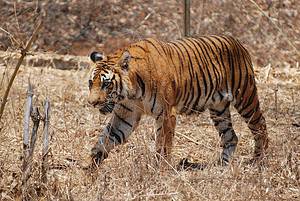
Tigers are the world’s largest cat species, often inspiring both awe and fear in humans. These apex predators are solitary and territorial, qualities that have shaped their symbolic meanings over time. The tiger is a prominent figure in both Chinese and Korean mythology and folklore. Tigers also appear in Buddhist and Hindu spirituality. What does dreaming of tigers mean? This article explores tiger symbolism, the spiritual meanings of tigers, and how to interpret dreams about tigers.

Tigers are obligate carnivores, meaning they require a diet of animal flesh.
©Thorsten Spoerlein/Shutterstock.com
Dreaming of Tigers: Tiger Symbolism
The most common symbolic meanings of tigers are strength, power, and independence. These meanings come from the unique qualities of tigers. Tigers are apex predators, meaning they are not the natural prey of any other animal. This quality gives them their symbolic meanings of strength and power. Additionally, tigers are primarily solitary creatures, which is why they symbolize independence.
Dreaming of Tigers: Tigers in Spirituality

Tigers were once widely distributed across Asia, but today are limited to pockets of South and East Asia.
©Volodymyr Burdiak/Shutterstock.com
Tigers have a long history as spiritual and cultural symbols in both China and Korea. Additionally, they appear in Buddhist and Hindu spirituality. Let’s explore the spiritual meaning of tigers in each of these distinct cultures and religions.
Tigers in Chinese Culture
Tigers have been an important figure in Chinese culture for thousands of years. They even appear in art from the Neolithic Age, predating the Chinese empire. To this day, archaeologists continue to discover Neolithic art featuring depictions of tigers. According to Xinhua, China’s official news agency, in June of 2023 archaeologists found a Neolithic stone axe with a carving of a tiger in Wuxi City that dates to 4,500 BCE. The first appearance of tigers in Chinese written history is in the oracle bone scripts of the Shang dynasty, which lasted from 1600-1045 BCE.
Tigers appear in Chinese spirituality, mythology, and the zodiac. In Daoist spirituality, the tiger represents masculine yang energy, while the dragon represents feminine yin energy. Tigers are also one of the 12 Chinese zodiac signs. People born in the year of the tiger are said to be strong, noble, and brave.
Tigers in Korean Culture
The tiger is a deeply important figure in Korean culture, especially in Korean foundation mythology. In the Korean origin myth, first written around the year 1,270, a tiger and a bear ask the god Hwanung to turn them into humans. Hwanung told the tiger and bear to fast. The bear fasted and became a human while the tiger failed because he ate. However, tigers became a symbol of protection and an important figure in Korean art throughout history. The figure of the tiger commonly appears around tombs, serving to guard the deceased.
Tigers in Buddhism
The tiger appears as a figure in Buddhism, a widely popular and diverse religion that began around the 5th century BCE. In the Mahayana and Tibetan Buddhist traditions, the tiger sometimes represents one of the Three Poisons. The Three Poisons is a concept describing character flaws that should be overcome. The tiger is the symbol of Dvesha, which translates to anger or hatred.
Tigers in Hinduism
The tiger is also a symbol in Hinduism, appearing in physical depictions of prominent gods. Shiva, a prominent and complex god, often sits upon or wears a tiger skin. This represents his ultimate power. Additionally, the tiger appears in depictions of Durga, the goddess of strength, motherhood, and war. Durga is often riding a tiger, evidence of her power and strength.
Tiger Dream Interpretations

Tigers are majestic and powerful animals that can inspire both awe and fear.
©iStock.com/Byrdyak
The tiger has fascinated and inspired humans for centuries. Let’s explore how we can interpret dreaming of tigers. A great way to begin is by examining your own personal relationship to the dream. Here are some questions to begin your search for meaning:
- What did you think or feel when you saw the tiger?
- What was the tiger doing?
- How do you think of tigers in your waking life?
- What were your first thoughts and feelings upon waking up?
These questions can begin to uncover what seeing a tiger in a dream means for you specifically. In addition to the unique elements an individual brings to the meaning of dreams, one can also draw upon traditional tiger symbolism.
Tigers commonly represent power, strength, bravery, and independence. Thinking about how you relate to these qualities, along with how a tiger appears in your dream, can help uncover the dream’s potential meanings for your life.
For example, some people may pursue power to an extreme degree, while others may be afraid to reasonably explore their personal power. Additionally, some people may tend toward higher or lesser degrees of independence. Tiger dreams can help bring reflection and balance to how we relate to the qualities of power and independence.
The photo featured at the top of this post is © iStock.com/Henris94
Thank you for reading! Have some feedback for us? Contact the AZ Animals editorial team.







